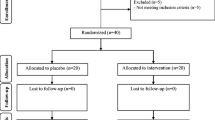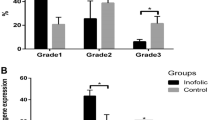Abstract
This study was performed to determine the effects of selenium supplementation on clinical symptoms and gene expression related to inflammatory markers in infertile women with polycystic ovary syndrome (PCOS) who were candidate for in vitro fertilization (IVF). Thirty-six women candidate for IVF were recruited in this randomized double-blinded, placebo-controlled trial. They (n = 18/group) were randomly assigned into intervention groups to take either 200 μg/day of selenium or placebo for 8 weeks. RT-PCR findings indicated that selenium supplementation downregulated gene expression of interleukin-1 (IL-1) (P < 0.004) and tumor necrosis factor alpha (TNF-α) (P = 0.02) in lymphocytes of patients with PCOS compared with the placebo. In addition, selenium supplementation upregulated gene expression of vascular endothelial growth factor (VEGF) (P = 0.001) in lymphocytes of patients with PCOS compared with the placebo. Selenium supplementation had no significant effect on clinical symptoms and gene expression of IL-8 (P = 0.10) and transforming growth factor beta (TGF-β) (P = 0.63). Overall, our findings documented that selenium supplementation for 8 weeks to infertile women candidate for IVF improved IL-1, TNF-α, and VEGF gene expression, though selenium had no effect on clinical symptoms and, IL-8 and TGF-β gene expression. Clinical trial registration number: http://www.irct.ir: IRCT20170513033941N23.



Similar content being viewed by others
References
Gonzalez F (2012) Inflammation in polycystic ovary syndrome: underpinning of insulin resistance and ovarian dysfunction. Steroids 77:300–305
Ecklund LC, Usadi RS (2015) Endocrine and reproductive effects of polycystic ovarian syndrome. Obstet Gynecol Clin N Am 42:55–65
Thessaloniki ESHRE/ASRM-Sponsored PCOS Consensus Workshop Group (2008) Consensus on infertility treatment related to polycystic ovary syndrome. Hum Reprod 23:462–477
Ng EH, Tang OS, Ho PC (2000) The significance of the number of antral follicles prior to stimulation in predicting ovarian responses in an IVF programme. Hum Reprod 15:1937–1942
Heijnen EM, Eijkemans MJ, Hughes EG, Laven JS, Macklon NS, Fauser BC (2006) A meta-analysis of outcomes of conventional IVF in women with polycystic ovary syndrome. Hum Reprod Update 12:13–21
Sarapik A, Velthut A, Haller-Kikkatalo K et al (2012) Follicular proinflammatory cytokines and chemokines as markers of IVF success. Clin Dev Immunol 2012:606459
Gao MZ, Zhao XM, Lin Y, Sun ZG, Zhang HQ (2012) Effects of EG-VEGF, VEGF and TGF-beta1 on pregnancy outcome in patients undergoing IVF-ET treatment. J Assist Reprod Genet 29:1091–1096
Ju W, Li X, Li Z, Wu GR, Fu XF, Yang XM, Zhang XQ, Gao XB (2017) The effect of selenium supplementation on coronary heart disease: a systematic review and meta-analysis of randomized controlled trials. J Trace Elem Med Biol 44:8–16
Jamilian M, Razavi M, Fakhrie Kashan Z, Ghandi Y, Bagherian T, Asemi Z (2015) Metabolic response to selenium supplementation in women with polycystic ovary syndrome: a randomized, double-blind, placebo-controlled trial. Clin Endocrinol 82:885–891
Zhang Z, Gao X, Cao Y, Jiang H, Wang T, Song X, Guo M, Zhang N (2015) Selenium deficiency facilitates inflammation through the regulation of TLR4 and TLR4-related signaling pathways in the mice uterus. Inflammation 38:1347–1356
Zamamiri-Davis F, Lu Y, Thompson JT, Prabhu KS, Reddy PV, Sordillo LM, Reddy CC (2002) Nuclear factor-kappaB mediates over-expression of cyclooxygenase-2 during activation of RAW 264.7 macrophages in selenium deficiency. Free Radic Biol Med 32:890–897
Rotterdam ESHRE/ASRM-Sponsored PCOS Consensus Workshop Group (2004) Revised 2003 consensus on diagnostic criteria and long-term health risks related to polycystic ovary syndrome. Fertil Steril 81:19–25
Dunkley PR, Jarvie PE, Robinson PJ (2008) A rapid percoll gradient procedure for preparation of synaptosomes. Nat Protoc 3:1718–1728
Gallinelli A, Ciaccio I, Giannella L, Salvatori M, Marsella T, Volpe A (2003) Correlations between concentrations of interleukin-12 and interleukin-13 and lymphocyte subsets in the follicular fluid of women with and without polycystic ovary syndrome. Fertil Steril 79:1365–1372
Haider S, Knofler M (2009) Human tumour necrosis factor: physiological and pathological roles in placenta and endometrium. Placenta 30:111–123
Lee KS, Joo BS, Na YJ, Yoon MS, Choi OH, Kim WW (2000) Relationships between concentrations of tumor necrosis factor-alpha and nitric oxide in follicular fluid and oocyte quality. J Assist Reprod Genet 17:222–228
Brigelius-Flohe R, Banning A, Kny M, Bol GF (2004) Redox events in interleukin-1 signaling. Arch Biochem Biophys 423:66–73
Kontic-Vucinic O, Sulovic N, Radunovic N (2006) Micronutrients in women’s reproductive health: II. Minerals and trace elements. Int J Fertil Womens Med 51:116–124
Kontic-Vucinic O, Sulovic N, Radunovic N (2006) Micronutrients in women’s reproductive health: I. Vitamins. Int J Fertil Womens Med 51:106–115
Ebisch IM, Thomas CM, Peters WH, Braat DD, Steegers-Theunissen RP (2007) The importance of folate, zinc and antioxidants in the pathogenesis and prevention of subfertility. Hum Reprod Update 13:163–174
Silberstein T, Saphier O, Paz-Tal O, Gonzalez L, Keefe DL, Trimarchi JR (2009) Trace element concentrations in follicular fluid of small follicles differ from those in blood serum, and may represent long-term exposure. Fertil Steril 91:1771–1774
Razavi M, Jamilian M, Kashan ZF et al (2016) Selenium supplementation and the effects on reproductive outcomes, biomarkers of inflammation, and oxidative stress in women with polycystic ovary syndrome. Horm Metab Res 48:185–190
Jamilian M, Mansury S, Bahmani F, Heidar Z, Amirani E, Asemi Z (2018) The effects of probiotic and selenium co-supplementation on parameters of mental health, hormonal profiles, and biomarkers of inflammation and oxidative stress in women with polycystic ovary syndrome. J Ovarian Res 11:80
Kose SA, Naziroglu M (2014) Selenium reduces oxidative stress and calcium entry through TRPV1 channels in the neutrophils of patients with polycystic ovary syndrome. Biol Trace Elem Res 158:136–142
Mohammad Hosseinzadeh F, Hosseinzadeh-Attar MJ, Yekaninejad MS, Rashidi B (2016) Effects of selenium supplementation on glucose homeostasis and free androgen index in women with polycystic ovary syndrome: a randomized, double blinded, placebo controlled clinical trial. J Trace Elem Med Biol 34:56–61
Jamilian M, Samimi M, Afshar Ebrahimi F, Aghadavod E, Mohammadbeigi R, Rahimi M, Asemi Z (2018) Effects of selenium supplementation on gene expression levels of inflammatory cytokines and vascular endothelial growth factor in patients with gestational diabetes. Biol Trace Elem Res 181:199–206
Han Y, Li C, Su M, Wang Z, Jiang N, Sun D (2017) Antagonistic effects of selenium on lead-induced autophagy by influencing mitochondrial dynamics in the spleen of chickens. Oncotarget 8:33725–33735
Wang H, Bi C, Wang Y, Sun J, Meng X, Li J (2018) Selenium ameliorates Staphylococcus aureus-induced inflammation in bovine mammary epithelial cells by inhibiting activation of TLR2, NF-kappaB and MAPK signaling pathways. BMC Vet Res 14:197. https://doi.org/10.1186/s12917-018-1508-y
Daeian N, Radfar M, Jahangard-Rafsanjani Z, Hadjibabaie M, Ghavamzadeh A (2014) Selenium supplementation in patients undergoing hematopoietic stem cell transplantation: effects on pro-inflammatory cytokines levels. Daru 22:51. https://doi.org/10.1186/2008-2231-22-51
Orostica L, Astorga I, Plaza-Parrochia F et al (2016) Proinflammatory environment and role of TNF-alpha in endometrial function of obese women having polycystic ovarian syndrome. Int J Obes (Lond) (2005) 40:1715–1722
Zhang W, Zhang R, Wang T, Jiang H, Guo M, Zhou E, Sun Y, Yang Z, Xu S, Cao Y, Zhang N (2014) Selenium inhibits LPS-induced pro-inflammatory gene expression by modulating MAPK and NF-kappaB signaling pathways in mouse mammary epithelial cells in primary culture. Inflammation 37:478–485
Mattmiller SA, Carlson BA, Sordillo LM (2013) Regulation of inflammation by selenium and selenoproteins: impact on eicosanoid biosynthesis. J Nutr Sci 2:e28. https://doi.org/10.1017/jns.2013.17
Narayan V, Ravindra KC, Liao C, Kaushal N, Carlson BA, Prabhu KS (2015) Epigenetic regulation of inflammatory gene expression in macrophages by selenium. J Nutr Biochem 26:138–145
Bazazzadegan N, Dehghan Shasaltaneh M, Saliminejad K, Kamali K, Banan M, Khorram Khorshid HR (2017) Effects of herbal compound (IMOD) on behavior and expression of Alzheimer’s disease related genes in streptozotocin-rat model of sporadic Alzheimer’s disease. Adv Pharm Bull 7:491–494
Song SH, Kim JE, Koh EK, Sung JE, Lee HA, Yun WB, Hong JT, Hwang DY (2018) Selenium-loaded cellulose film derived from Styela clava tunic accelerates the healing process of cutaneous wounds in streptozotocin-induced diabetic Sprague-Dawley rats. J Dermatolog Treat 29:606–616
Tawfik KM, Moustafa YM, El-Azab MF (2018) Neuroprotective mechanisms of sildenafil and selenium in PTZ-kindling model: implications in epilepsy. Eur J Pharmacol 833:131–144
Ferrara N, Gerber HP, LeCouter J (2003) The biology of VEGF and its receptors. Nat Med 9:669–676
Boudjenah R, Molina-Gomes D, Wainer R, de Mazancourt P, Selva J, Vialard F (2012) The vascular endothelial growth factor (VEGF) +405 G/C polymorphism and its relationship with recurrent implantation failure in women in an IVF programme with ICSI. J Assist Reprod Genet 29:1415–1420
Banyasz I, Szabo S, Bokodi G, Vannay A, Vasarhelyi B, Szabo A, Tulassay T, Rigo J (2006) Genetic polymorphisms of vascular endothelial growth factor in severe pre-eclampsia. Mol Hum Reprod 12:233–236
Jinno M, Ozaki T, Iwashita M, Nakamura Y, Kudo A, Hirano H (2001) Measurement of endometrial tissue blood flow: a novel way to assess uterine receptivity for implantation. Fertil Steril 76:1168–1174
Kim A, Jung H, Choi WJ, Hong SN, Kim HY (2014) Detection of endometrial and subendometrial vasculature on the day of embryo transfer and prediction of pregnancy during fresh in vitro fertilization cycles. Taiwan J Obstet Gynecol 53:360–365
Streicher KL, Sylte MJ, Johnson SE, Sordillo LM (2004) Thioredoxin reductase regulates angiogenesis by increasing endothelial cell-derived vascular endothelial growth factor. Nutr Cancer 50:221–231
Funding
This study was supported by a grant from the Vice-chancellor for Research, Shahid Beheshti University of Medical Sciences, Tehran, Iran.
Author information
Authors and Affiliations
Contributions
ZA helped in conception, design, and statistical analysis of the manuscript. ZH, NH, SZ-M, MM, EA, and M-HP contributed in data collection and manuscript drafting. ZA supervised the study.
Corresponding author
Ethics declarations
Conflict of Interest
The authors declare that they have no conflict of interest.
Additional information
Publisher’s Note
Springer Nature remains neutral with regard to jurisdictional claims in published maps and institutional affiliations.
Rights and permissions
About this article
Cite this article
Heidar, Z., Hamzepour, N., Zadeh Modarres, S. et al. The Effects of Selenium Supplementation on Clinical Symptoms and Gene Expression Related to Inflammation and Vascular Endothelial Growth Factor in Infertile Women Candidate for In Vitro Fertilization. Biol Trace Elem Res 193, 319–325 (2020). https://doi.org/10.1007/s12011-019-01715-5
Received:
Accepted:
Published:
Issue Date:
DOI: https://doi.org/10.1007/s12011-019-01715-5




